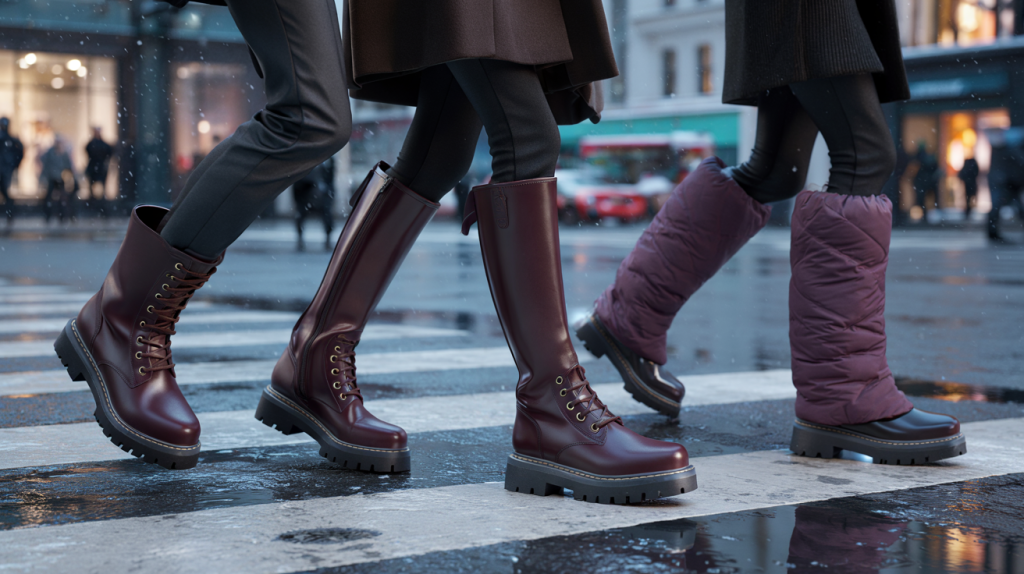Clicks were not in vain. Winter boots 2025 bring a clear shift, with chunky lug soles moving into the everyday wardrobe, sleek city silhouettes gaining ground, and alpine hikers returning in rich leathers and deep chocolate tones. Shearling trims, tall shafts that skim the knee, and waterproof membranes now sit side by side, so style and storm protection finally meet.
The direction has been set on runways and trade floors, from Pitti Uomo in January 2025 to Micam Milano in February 2025. Brands push lighter midsoles, bigger tread geometry, and smarter insulation that still breathes on the commute. The message is simple, and timely, icy pavements need grip, long days ask for comfort, and people want pairs that look sharp from 8 to late.
Winter Boots 2025 trends, from lug soles to sleek city lines
Three families dominate. First, the utility look, with thick rubber bottoms, pronounced lugs, and matte leathers that age well. Think hiker inspired shapes refined for the city, eyelets in brushed metal, and toe boxes that feel compact, not clunky.
Second, tall boots return with intent, riding and equestrian codes, buttery calf leather, and shafts that hold their shape. A clean line, a quiet buckle, and hues like espresso, sand, and dark aubergine draw attention without shouting.
Third, cocoon comfort goes visible. Shearling cuffs peek over ankles, insulated snow boots slim down, and quilted nylon gets elevated with tonal stitching. Metallic accents appear in a restrained way, a zipper pull, a heel tab, a subtle plate. Not more.
Warmth and grip, what actually keeps feet safe on ice
Insulation matters, but not all padding equals warmth. Primaloft has stated its Gold insulation keeps up to 98 percent of warmth when wet, a useful benchmark when slush creeps in. Merino liners also help regulate sweat, and Woolmark notes wool can hold around 30 percent of its weight in moisture before feeling damp. That buffer buys comfort on long days.
Grip starts with rubber chemistry and tread depth. Look for deep, multi directional lugs that clear snow quickly, plus defined heel brakes to control each step on descents. Some outsoles integrate micro glass or specific ice formulas, and Vibram markets Arctic Grip for wet ice traction. Try the outsole on a smooth store tile, press and twist, feel the bite under load.
Waterproofing sits in layers. Full grain leather with sealed seams resists salt and splash when regularly conditioned. Membranes zip moisture out while blocking water in, but breathability varies. If feet run warm, favor membrane models with mesh lining and a removable insole to tune comfort with thicker socks.
Materials and sustainability, labels that actually mean something
People look at the hangtag now, not just the silhouette. Leather from tanneries audited by the Leather Working Group signals reduced water use and better chemical management, a practical step forward. Recycled rubbers appear in midsoles and outsoles, often visible as light speckling, without sacrificing durability for daily wear.
Interest has shifted to animal free options as well. High quality polyurethane uppers feel convincing, especially when backed with microfiber that wicks. Care still counts, wipe salt quickly, use a gentle cleaner, and add conditioner made for synthetics to avoid creasing. The goal stays the same, make pairs last longer, waste less.
On the market side, growth is steady. McKinsey’s “State of Fashion 2024” projected footwear to expand at roughly 3 to 4 percent a year through 2027, which explains why brands double down on core winter silhouettes. More demand, more choice, smarter features.
How to choose your 2025 pair, fit, care, and budget that works
Start with the use case. City commuting needs waterproof leather, a warm yet breathable lining, and a tread that grips wet concrete. Mountain weekends ask for higher shafts, toe protection, and insulation you can trust below freezing. The shape of the foot decides the last, wide feet benefit from rounded toe boxes and a little extra forefoot volume.
Try boots in the afternoon with the socks planned for winter. Feet swell during the day, and a half size can change everything. Lace tension should hold the heel firmly while letting toes move. If arches fatigue, add a supportive insole and re test. Yes, those small tweaks save the week.
Care locks value. Salt stains leather in hours, so wipe with a damp cloth at night, then condition once dry. Rotate pairs to let lining moisture evaporate, at least 24 hours between wears. Store with simple shoe trees to keep the shaft smooth.
For a quick filter during shopping, this helps.
- Outsole with visible, varied lugs and a defined heel brake
- Seam sealing or a trusted waterproof membrane plus a gusseted tongue
- Lining that matches your climate, light fleece for mild cold, technical insulation for deep winter
- Upper in full grain leather or robust synthetic with reinforced toe and heel
- Room for winter socks without heel lift, check with an in store walk
Finally, weigh price against daily cost. A well built pair worn 90 days each winter across three seasons costs far less per wear than a bargain that fails by March. If budget is tight, target last year’s colorways during January 2025 markdowns, quality often stays identical. That said, act fast, popular sizes go quickly, almost definitly.
